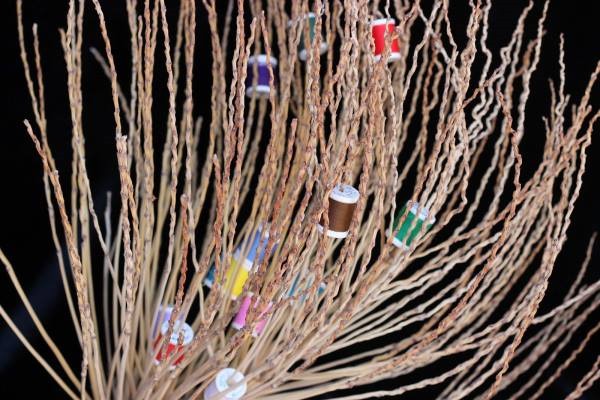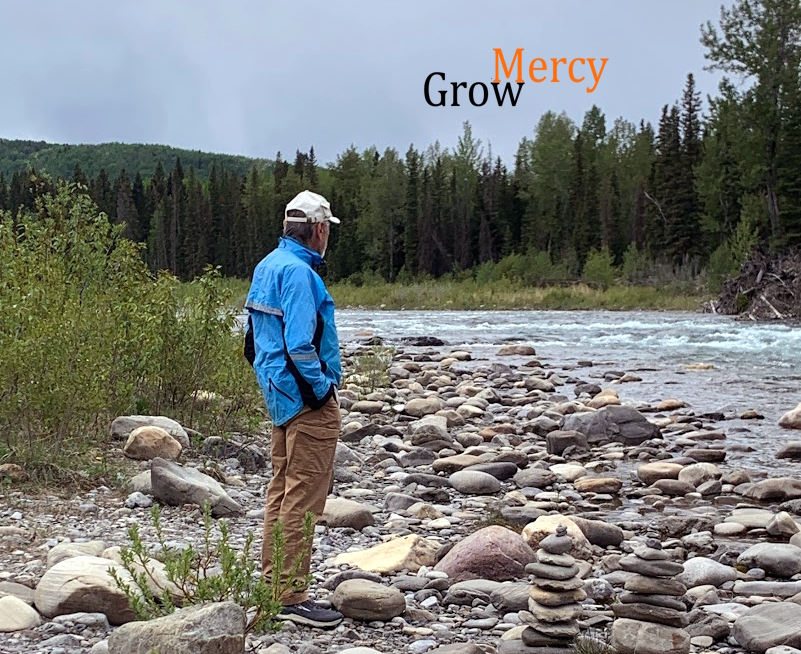These days I’m thinking about a metaphor found in the writings of Simone Weil: Two prisoners in adjoining cells are divided by a rock wall. Over what must be imagined to be a very long time, they devise a way to communicate using a series of taps and scratches. The wall is the thing that separates them, but it is also their only means of communication. “It is the same with us and God,” says Weil. “Every separation is a link.” 
( Mi Vida Landscapes – adela c. licona )
The wall is our world, this leaf, that hawk, these trees, our bodies, the entire created order. The taps and scratches, our language.
It’s a metaphor that appeals to me. It explains my years of increasing—now thorough—unease with statements of faith concerning inerrancy and infallibility: doctrines thought to streak like comets far above our gluey earth. It also gets at my distrust of the easy spirituality within certain enclaves of liberal Protestantism, as well the breezy Christianity of some seeker-simpatico Evangelical churches. The former (Fundamentalists) believe they have razed the wall, the later (Liberals) pretend it isn’t there.
The metaphor also explains my inability to give my doubt wholly over to atheism. That is, it explains my equal unease in the “fundamentalism,” of the “new” atheists—who, Christian Wiman in a poem I can’t locate just now, called, the anvil-eyed atheists that scream, reason! To these, the wall is just that.
But perhaps that’s too harsh. I’ve found atheism useful for exterminating a series of ghetto gods that have been handed down, gods of superstition, sacrifice, wrath, patriarchy, ecclesial hierarchy, and any number of other archys.
Besides, “An atheist may be simply one whose faith and love are concentrated on the impersonal aspects of God,” (Simone Weil again), which of course is a theist’s eye-view and may be offensive to atheists.
The metaphor also gives my day-to-day unease a place to rest. It’s a figure of absence and doubt, presence and possibility, and because it is all these things at once, it pours energy into what is my own lived reality, and helps me stand and walk.
Finally, not least of all, the image explains my devotion to poetry—a latent devotion that in the past decade or so has become something like a way of breathing.
Poetry, it seems to me, has the range of taps and scratches (not to detract from the poetry found in some prose, or to think of it now, the “poetry” that can spring from any art form), that takes into account and best understands the limits of language, because it continually tests, yet works with those limits.
Where theology aspires to climb over the wall, poetry is written at ground level, concerned and consumed by what is there. (In this sense I see poetry as a kind of creative nonfiction.) In other words, poets are all about the wall—love the wall, listen to it for its limits and potential, know it as the link it is. Receive from it, their faith, even as their faith is constantly being defeated (and remade) by it.
Poets also know the distancing involved in relaying that first tap, that impulse that seems to come from beyond will and reason. A poet will be struck, sometimes suddenly, by a kind innocence and otherness of image, but will experience, through the conscious labour of expression, its loss. This is the sorrow of poets, and in a way, their gift.
And yet in the hands of great poets (Hopkins, Dickens, George Herbert, more recently Levertov, Fanny Howe, Christian Wiman et al), a poem will crest so close to the immediacy of experience, and be strung and sung in such a way, that we hear, unmistakably, communally, inclusively, a returned knock.
What do we need? We need a faith resilient enough to withstand the suffering and loss inherent in life, and expansive enough to celebrate the many joys that surprise and enliven.
We have no direct access to bedrock, but we do need a kind of certainty, a provisional surety, a lamp at our feet, a new kind of dress. What I’m saying is that we need a poetics of belief.
O unworn world enrapture me, encapture me in a web
Of fabulous grass and eternal voices by a beech,
Feed the gaping need of my senses, give me ad lib
To pray unselfconsciously with overflowing speech
For this soul needs to be honoured with a new dress woven
From green and blue things and arguments that cannot be proven. – Patrick Kavanagh

“a poem will crest so close to the immediacy of experience, and be strung and sung in such a way, that we hear, unmistakably, communally, inclusively, a returned knock. – ”
Not a religion…
…but a relationship…
Yes – that is what we need.
Oh the gift of ‘poetic license’ !
Thank you Ike, I will take that in the best possible sense. 🙂
Thank you “Cdreamgirl”!
The leaf, the hawk, the body as a wall separating and communicating in an absence adds to meaning I found in Daniel Coleman’s description of reading as a spiritual experience which reaches out to connect with the absent author.
(In Bed With The Word) You tapped on the wall for me, thank you.
every separation a link… every border, a bridge. what divides, unites. it is both / and, rather than either / or. all things connected and related. nothing stands, can stand, alone. this makes sense – or rather, is meaningful – to me, stephen. thanks for the reflection and the arrival there through an understanding of the poetics of un/belief… an invitation to be sure.
There is such a thing as a useful atheism … to dethrone the gods we construct.
I loved your critique of the various theological stances those whom we live among have adopted, and find myself needing to check my arrogant cynicism…
The wall as a link … “now we see through a glass dimly” (1 Cor. 13)
Thank you Ray. That kind of reading sounds like the Benedictine practice of Lectio Devina, a slow, meditative, tasting, open to connection.
Adela, thank you for your insight. Yes, poetics of un/belief…the generative tension of doubt, absence, possibility, presence.
And thank you for the use of your ‘tailoring whimsey’ image. Somehow it seemed an apt image of those connections, a beautiful instance of working within limits and straining beyond.
Thank you Sam. Yes, the Corinthian reference is good. Darkly…riddle, enigma, mystery. Funny though, how I remember those old sermons treating this reference, or rather what this reference was referring to, from a position of hermeneutical clarity–already having arrived, “face to face.”